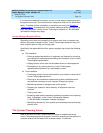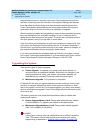
MERLIN LEGEND Communications System Release 5.0
System Manager’s Guide
555-650-118
Issue 1
June 1997
About the System
Page 2-6Background
2
■ Digital Signal. Information transmitted in a coded form (from a computer)
represented by discrete signal elements; for example, off and on or zero
and one.
Switching Equipment 2
As described earlier, the telephone network is composed of a number of
centralized switching locations, call
central offices
(
COs
), where a telephone
circuit is connected, or switched, to another circuit. That is, the caller’s line is
connected to the called party’s line so the two can hold a conversation.
Telephone operators, who supplied the first manual switching, were slow and
costly but afforded some special functionality: calls could be forwarded, messages
taken, and calls interrupted. Electromechanical switching automated that manual
labor and made telephone service universally affordable, but the technology was
inflexible and did little more than switch calls. Now, with electronic,
computer-controlled switches, both flexibility and functionality are affordable for
everyone.
The Evolution of Switches 2
The method, type, capabilities, and capacities of switches have evolved as
geographic areas expanded and technological advances became available. The
following list describes each of these progressive innovations. Figure 2–3
illustrates this evolution of switching equipment.
■ Private-Line Service. In the first telephone installations, communication
was directly from one telephone to another, as in Bell’s demonstration.
Thus, one telephone could communicate with only one other telephone.
■ Party-Line Service. Several telephones were connected to one line so
that a number of people could communicate in the same conversation. But
there was no way to reach a telephone on any other line.
■ Station Switching. All telephones were connected to all other telephones.
The telephone itself performed the switching and made the connection.
This was workable for a small number of telephones, but quickly became
impractical as hundreds of telephones were installed.
■ Centralized Switching. As the number of telephones grew, all the lines
from all the telephones came to a common
central office (CO)
or
exchange
,
so that the lines could be electrically cross-connected. Human operators
made the connections.


















